Iran won't build nuclear weapon in 2012, says draft Isis report
Analysis by Institute for Science and International Security says sanctions and threat of Israeli attack are having effect
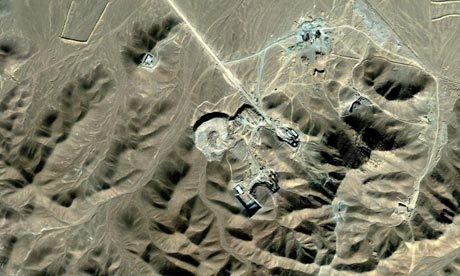
Aerial view of what is believed to be Iran's nuclear facility at Qom. The Isis report says a military strike against Iran's nuclear enrichment facilities would have little effect on any programme to build a bomb. Photograph: EPA
Iran is unlikely to move towards building a nuclear weapon in 2012 because it cannot yet produce enough weapon-grade uranium and is being deterred by sanctions and the prospect of an Israeli attack, according to a draft report by the Institute for Science and International Security (Isis).
The report by the institute founded by nuclear expert David Albright offers a more temperate view of Iran's nuclear program than some of the heated rhetoric that has surfaced since the United States and its allies stepped up sanctions on Tehran.
The Isis analysis is revealed after a prediction that Israel will attack Iran in 2012 to try and stop any nuclear bomb programme.
"Iran is unlikely to decide to dash toward making nuclear weapons as long as its uranium enrichment capability remains as limited as it is today," the report said.
The US and Iran are engaged in a war of words over sanctions, with Tehran threatening to retaliate by blocking oil shipping traffic through the Strait of Hormuz. The United States has said it will not allow that to happen. There are concerns the situation might spiral into a military confrontation that neither side wants.
The Isis report, financed by a grant from the United States Institute of Peace, says Iran had not made a decision to build a nuclear bomb.USIP is an independent, non-partisan centre created by the US Congress in 1984 that receives federal government funding.
"Iran is unlikely to break out in 2012, in great part because it is deterred from doing so," says the Isis report, which has not yet been publicly released.
The report says sanctions and the fear of a military strike by Israel on Iran's nuclear facilities have worked as a deterrent.
The institute has advised US and foreign governments about Iran's nuclear capabilities and Albright is considered a respected expert on the issue. The report tracks closely with what is known of official US government assessments.
US officials say Iran's leaders have not made the decision to build a nuclear weapon.
Much of what the Iranians are doing with their nuclear program has civilian uses but they are keeping their options open, which significantly adds to the air of ambiguity, US officials have told Reuters on condition of anonymity.
Some conservative and Israeli analysts in the past have challenged these types of assessments, asserting that Iranian nuclear efforts are sufficiently advanced that they could build a bomb in a year or less.
But according to the Isis report: "Although Iran is engaged in nuclear hedging, no evidence has emerged that the regime has decided to build nuclear weapons."
"Such a decision may be unlikely to occur until Iran is first able to augment its enrichment capability to a point where it would have the ability to make weapon-grade uranium quickly and secretly."
It added that despite a report last November by the United Nations' International Atomic Energy Agency alleging that Iran had made significant progress on nuclear weaponisation, "Iran's essential challenge remains developing a secure capability to make enough weapon-grade uranium, likely for at least several nuclear weapons".
Some European intelligence officials have disputed a US national intelligence Estimate published in 2003 that said Iran had stopped working on a programme it had launched earlier to design and build a bomb.
The Europeans maintain Iran never stopped research and scientific development efforts that could be bomb-related.
Tensions spiked after Iran announced this month that it had begun to enrich uranium deep inside an underground facility near the holy city of Qom. The secretly built facility was publicly revealed by the United States in 2009.
The Isis report says a military strike to stop Iran building a bomb would be unlikely to succeed.
Limited military options, such as air strikes against nuclear facilities, are "oversold as to their ability to end or even significantly delay Iran's nuclear program," the report says. Limited bombing campaigns would be "unlikely to destroy Iran's main capability" to produce weapons-grade uranium.
Iran has taken precautions by dispersing the centrifuges it uses for enrichment to multiple locations, has mastered the construction of centrifuges, and has probably stockpiled extra centrifuges, the institute says.
A bombing campaign that did not totally eliminate these capabilities would leave Iran "able to quickly rebuild" its nuclear program and even motivate it to set up a Manhattan Project-style crash program to build a bomb, which would only make the region more dangerous and unstable, Isis says.
The report says clandestine intelligence operations aimed at detecting secret Iranian nuclear activities, including the construction of new underground sites, are "vitally important". Known methods used by spy agencies include the recruitment of secret agents, cyber spying operations, overhead surveillance by satellites and drones, and bugging of equipment that Iran buys from foreign suppliers.
The report says another "well-known tactic" used by western spy agencies against Iran has been to infiltrate Iranian networks that smuggle nuclear-related equipment and supply them with plans or items that are faulty or sabotaged. The report says this tactic has helped the west uncover at least one of Iran's secret nuclear sites and, according to official statements by the Iranians, has caused enrichment centrifuges to break.
Other more violent covert operations strategies, particularly the killing of Iranian nuclear scientists and engineers, have "serious downsides and implications", such as a high risk of Iranian retaliation through militant attacks that could be directed against civilian targets. The US has emphatically denied any involvement in killings such as the car bombing in January of Mostafa Ahmadi Roshan, 32, a chemistry expert and a director of the Natanz uranium enrichment plant in central Iran.
The report says that since thousands of specialists are involved in the Iranian nuclear program, assassinations are unlikely to be effective in slowing it down. It warns that Iran could construe assassinations as acts of war and use them to justify retaliation.
Pass notes No 3,113: Strait of Hormuz
The west sent in its warships after Iran threatened to block this vital oil route through which tankers carry 17m barrels each day
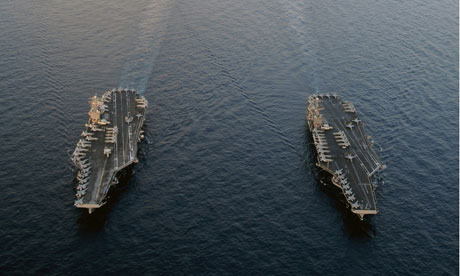
US aircraft carriers patrol near the Strait of Hormuz. Photograph: Reuters
Age: As old as the hills either side of it.
Appearance: Wet and warshippy.
Aha! The bit of water we keep seeing on the news. The one next door to Iraq … You mean Iran.
They're just different spellings of the same word, aren't they?Er…
But there's no room to go into that. Tell me about this strait thingy. It's the narrow passage where the Persian Gulf joins the Arabian Sea, and through that the rest of the Indian Ocean. To the north is Iran; to the south, the Musandam peninsula.
Which I've never heard of. It's an enclave of Oman. But if you're not sure what an enclave is …
Let's pretend I'm not. Then you need a dictionary as well as an atlas. The point is that if you want to get oil out of large areas of the Middle East, you have to go through Hormuz. According to G2's sources in the petrochemical industry-
Also known as Wikipedia … Don't disillusion the readers. On an average day tankers carry 17m barrels of crude oil through the strait. That's a fifth of the oil trade worldwide. Economically essential, yet easily blocked, the strait is what military strategists call a choke point.
When you say it's narrow … It's about 54km across at its tightest. To avoid collisions, there are separate lanes for inbound and outbound ships, each 3km across.
It must have been one hell of a job painting those white lines. Anyway, why is it full of warships? This is the latest stage in Iran's long run-in with the west. After the EU imposed an oil embargo on the country, and Iran then threatened to block the strait in retaliation, the US, the UK and France sent six military vessels through it on Sunday, led by a 100,000-tonne aircraft carrier. There are also rumours that the US is going to send mine-detecting dolphins to the area.
And how has Tehran reacted to all this? It's threatened to nuke the White House.
Seriously? Of course not. It hasn't finished building the bombs yet.
Not to be confused with: Dire Straits, hummus, Suez.
'Israel will indeed strike Iran in 2012'
One of Israel's leading strategic analysts says the country's leadership believes air strikes can set back the Iranian nuclear programme by three to five years

An Israeli Air Force F-16I jet fighter takes off after touching down briefly at the Ramon Air Force Base in the Negev Desert. Photograph: Jim Hollander/EPA
Ronen Bergman, an investigative journalist and analyst on the Israeli newspaper Yedioth Ahronoth has written a long piece for the New York Times magazine, asking the question on many people's minds: Will Israelattack Iran?
Bergman's answer, which comes in the last paragraph, is yes:
After speaking with many senior Israeli leaders and chiefs of the military and the intelligence, I have come to believe that Israel will indeed strike Iran in 2012. Perhaps in the small and ever-diminishing window that is left, the United States will choose to intervene after all, but here, from the Israeli perspective, there is not much hope for that. Instead there is that peculiar Israeli mixture of fear — rooted in the sense that Israel is dependent on the tacit support of other nations to survive — and tenacity, the fierce conviction, right or wrong, that only the Israelis can ultimately defend themselves.
Bergman is one of a small circle of heavyweights in the Israeli media who spend a significant amount of time with the politicians, spies and generals who are going to make the ultimate decision. So his assessment carries more weigh that your average Israel-Iran analyst. Here is one of the key paragraphs:
The Israeli Air Force is where most of the preparations are taking place. It maintains planes with the long-range capacity required to deliver ordnance to targets in Iran, as well as unmanned aircraft capable of carrying bombs to those targets and remaining airborne for up to 48 hours. Israel believes that these platforms have the capacity to cause enough damage to set the Iranian nuclear project back by three to five years.
Three to five years seems a very confident estimate. The US defence secretary, Leon Panetta, reckoned in December that such strikes could set the Iranians back one or two years "at best". Bergman also talks to a Mossad veteran, Rafi Eitan, whose own estimate was "not even three months".
Bergman spent a lot of time in recent months with the Israeli defence minister, Ehud Barak, and is particularly revealing on his strategic thinking. He does not necessarily share Binyamin Netanyahu's apocalyptic view of Iran's intentions, but believes a nuclear Iran will be more aggressive and harder to counter.
"From our point of view," Barak said, "a nuclear state offers an entirely different kind of protection to its proxies. Imagine if we enter another military confrontation with Hezbollah, which has over 50,000 rockets that threaten the whole area of Israel, including several thousand that can reach Tel Aviv. A nuclear Iran announces that an attack on Hezbollah is tantamount to an attack on Iran. We would not necessarily give up on it, but it would definitely restrict our range of operations."At that point Barak leaned forward and said with the utmost solemnity: "And if a nuclear Iran covets and occupies some gulf state, who will liberate it? The bottom line is that we must deal with the problem now."
Bruce Riedel, a former CIA Middle East specialist, takes the opposite view, arguing in Lebanon's Daily Star today that even with the bomb, Iran would not be an existential threat to Israel. Riedel's view probably reflects the majority outlook at the CIA and the White House. Bergman examines this divergence in American and Israeli assessments, and wonders how much notice Israel would give Washington of an attack. Matthew Kroenig, a former Pentagon advisor now at the Council on Foreign Relations, reckons it will be "an hour or two, just enough to maintain good relations between the countries but not quite enough to allow Washington to prevent the attack".
Jeffrey Goldberg has put out a piece in The Atlantic in response to Bergman, suggesting that Bergman's analysis might be premature, and pointing out that the same people that Bergman talked to had previously convinced Goldberg that the attack would come last summer. Clearly, Israeli has a motive in conveying the impression that an attack might be imminent, to stir up urgency in the West to confront Iran. Ultimately, as Bergman admits, only Netanyahu and Barak really know how much is bluff and how much real intention.
That is a lot more interesting stuff in Bergman's piece. He is bringing out a book this month, called The Secret War with Iran, (clarification: an updated English version of his 2007 book of the same title) which sounds like it will be a gripping read, and of course the NYT article helps drum up interest and sales. In it, Bergman gives a colourful description of a meeting in January 2011 with the outgoing Mossad boss, Meir Dagan, who has argued vehemently against an attack on Iran.
We were told to congregate in the parking lot of a movie-theater complex north of Tel Aviv, where we were warned by Mossad security personnel, "Do not bring computers, recording devices, cellphones. You will be carefully searched, and we want to avoid unpleasantness. Leave everything in your cars and enter our vehicles carrying only paper and pens." We were then loaded into cars with opaque windows and escorted by black Jeeps to a site that we knew was not marked on any map. The cars went through a series of security checks, requiring our escorts to explain who we were and show paperwork at each roadblock.This was the first time in the history of the Mossad that a group of journalists was invited to meet the director of the organization at one of the country's most secret sites.
Presumably there will be much more of this in the book. However, when it comes to covert operations, as with the nuclear programme, there are things that Israeli journalists know but cannot say, and must attribute to non-Israeli sources. For example, Bergman does not say outright that Israel is behind the assassinations of Israeli nuclear scientists but reports lots of nods and winks in that direction. Here is an example of the journalistic animut (opacity):
Operating in Iran ... is impossible for the Mossad's sabotage-and-assassination unit, known as Caesarea, so the assassins must come from elsewhere. Iranian intelligence believes that over the last several years, the Mossad has financed and armed two Iranian opposition groups, the Muhjahedin Khalq (MEK) and the Jundallah, and has set up a forward base in Kurdistan to mobilize the Kurdish minority in Iran, as well as other minorities, training some of them at a secret base near Tel Aviv.
Is Bergman really channeling Iranian intelligence here, or laundering something he knows by attributing it to Iranian intelligence? Hard to know for sure, but it certainly reads like the latter. So his NYT piece and probably his book will no doubt tell us a lot about Israel's intentions but not as much as Bergman undoubtedly knows.
Nuclear weapons: how many are there in 2009 and who has them?
Latest data on how many nuclear weapons there are in the world shows that - even with some being dismantled - there are still 23,574. Find out who has what
• Get the data
• Get the data
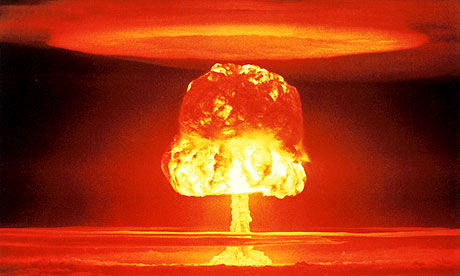
Nuclear weapons: Explosion over Bikini Atoll Photograph: U.S. Department of Energy-Nevada/Corbis
Are we headed for a nuclear-free world?
News that the US is abandoning the missile defense system has brought renewed attention to the issue of nuclear proliferation.
The thing is, counting nuclear weapons is a bit like counting votes – a lot depends on who is doing the counting, and how.
The disarmament treaty currently being negotiated between the US and Russia applies to deployed strategic warheads, along with their delivery systems, but that leaves out most of the weapons both countries are sitting on.
Roll over the line to get the figures
It does not apply to short-range, tactical weapons like nuclear artillery shells, depth charges and anti-ballistic missiles, of which the US has an estimated 500 and Russia has about 2,000. They do not represent an immediate threat to either of the nuclear superpowers, so they have been left to one side, although they represent a significant proliferation risk.
Such warheads, being smaller, are arguably easier to steal.
Then there is the distinction between deployed, reserve and retired warheads. The new deal, like the 2002 Moscow Treaty, deals with deployed warheads, that are installed atop missiles ready to fire, or in the form of bombs ready to load on to planes.
But there is a lot more destructive force sitting in the American and Russian warehouses in the form of reserve arsenals. Much of the disarmament of recent years has involved warheads being removed from missiles and stored in bunkers, under constant maintenance.
They can be reunited with their missiles in a matter of days or weeks. In the case of gravity bombs, the distinction between deployed and reserve stockpiles is even more blurred. In the American case, for example, it depends on whether they are stored on 'forward' air bases in Europe, or back in the US.
The third category is 'retired for dismantlement'. The warheads are separated from their delivery systems and warehoused without maintenance.
In some cases, trigger mechanisms are removed to prevent them blowing up unexpectedly. They are supposed to be taken apart, but in reality the wait can last years. The US has 4,200 such warheads and is only dismantling them at the rate of 270 a year. Russia is thought to have about 8,000 non-deployed warheads, but it is unclear how many are in reserve and how many retired. The best guess by independent nuclear experts is that the overwhelming majority of that number is retired awaiting dismantlement.
Despite the fact the retired stockpiles represent the biggest category of nuclear weapons out there they are not normally counted as part of each country's arsenal for the purposes of treaties, even though no technical reason they could not be put back into service relatively fast if international tensions took a sudden turn for the worse.
The data here – updated with the latest figures on the US and Russia - is from the Bulletin of Atomic Scientists – the world's best source of nuclear information. See what you can do with it – and let us know.
Flickr Please post your visualisations and mash-ups on our Flickr groupor mail us at datastore@guardian.co.uk
Where do people from across Europe live? Photograph: Alamy
How many Poles live in France and how many French live in Italy? As part of the Guardian's Europa series we have compiled numbers on which citizens live where within France, Spain, Italy, Germany, Polandand the UK.
Using the most up to date figures of officially registered inhabitants we could find in each country we have brought them all together to get a better look at who exactly lives where. With the help of figures fromEurostat and the ONS here in the UK, we are able to compare the number of inhabitants by country and nationality.
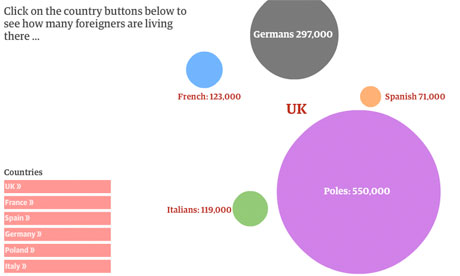 Who lives where in Europe? Click to see the interactive. By Paddy Allen
Who lives where in Europe? Click to see the interactive. By Paddy AllenThe great interactive created by the Guardian's infographics editor,Paddy Allen shows the number of citizens inhabiting each country. We have focused on six countries in our European special so have also seen how many citizens of each of those countries live in each place. For example in the UK there are 123,000 French inhabitants whereas in France there are 150,000 UK citizens living in the country.
So what does the data show us? The UK is home to more Polish citizens than each of the other five countries featured. Poland has over 4,400 German citizens currently residing in the country and a mere 764 officially registered UK citizens.
Spain still holds a draw for many Brits as 390,880 inhabit the country whereas the Spanish it seems prefer to settle in France. With over 550,000 Italian people, Germany seems a popular choice for their European friends. For the French, the UK is a popular choice for emigration followed very closely by Spain.
The bar chart above shows the number of officially registered inhabitants in each country by nationality. Click on the graph to see how many of each nationality live where. Below is a table of the figures used in the chart and in our interactive.
What can you do with this data?
Data summary
EU budget: what does the European Union spend and where does the money come from?
How does the EU spend its budget - and who contributes the most? Scroll down to explore the graphic
• Get the data
• Download the graphic as a PDF
• Get the data
• Download the graphic as a PDF
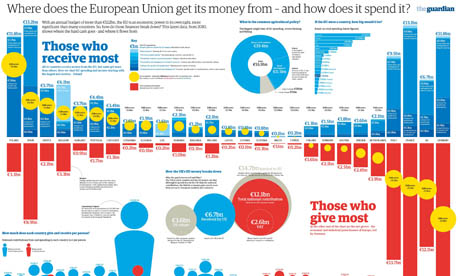
EU budget: what does the European Union spend and where does the money come from? Download the graphic as a PDF
Where does the European Union get its money from‚ and how does it spend it?
With an annual budget of over €122bn, the EU is an economic power in its own right, more significant than many countries. So, how do those finances break down? This latest detailed data - from 2010 - shows where the hard cash goes - and where it flows from. As part of our Europa series, we wanted to look at how the figures break down.
Extracted from the EU budget site, we've gone for the most detailed recent numbers.
Most of the EU's money comes from member nation contributions, €108.5bn in 2010. It's not completely straightforward - especially if you use the UK as an example.
So, this is how it goes:
• €14.7bn is the total raised from the UK. This includes money raised in duties within the UK and passed on to the EU. The UK receives a 25% fee of €837.8m for this. Within that…
• €12.15bn is the UK's national contribution, which is largely based on the size of our economy. It also includes other adjustments and €2.63bn from VAT
• -€3.56bn in rebates negotiated by Margaret Thatcher in 1984, called the 'UK correction' in the official data. This is paid for by other EU member states
Guardian graphic artist Paul Scruton's has visualised the key data here:
Explore the graphic
So, where does the money go? €111bn of it is spent inside the EU - the rest goes on aid and development outside the community. These are the official definitions - and what they really mean.
• Administration Running the EU in each country
• The EU as a global partner International aid, activities outside the EU
• Citizenship, freedom, security and justice Asylum, education and culture
• Preservation and management of natural resources Common agricultural policy, environment, fishing
• Cohesion for growth and employment Helping poorer regions ofEurope
• Competitiveness for growth and employment Economic growth grants to small business, science and research
• The EU as a global partner International aid, activities outside the EU
• Citizenship, freedom, security and justice Asylum, education and culture
• Preservation and management of natural resources Common agricultural policy, environment, fishing
• Cohesion for growth and employment Helping poorer regions ofEurope
• Competitiveness for growth and employment Economic growth grants to small business, science and research
Germany, as the biggest economy, is also the biggest contributor, Poland is the biggest receiver. The UK contributes much more than it receives too, about €5.4bn more. Why the gap? The UK is a rich country and the EU points out that although it spends less in the UK than the national contribution, the British economy gains much more from access to European markets and contracts. UK exports to the EU were worth £13.9bn (€16.6bn) in November last year alone.
How much does each country give and receive per person? If you look at national contributions from and spending in each country in, Luxembourg is the biggest receiver in Europe. However, those figures are skewed by its tiny population of 502,000 people and the fact that it is home to several EU institutions, including the European Court of Justice, theEuropean Court of Auditors, Eurostat and the Secretariat of the European Parliament.
This is just a skim through the data. You can download the full spreadsheet below or download the graphic as a PDF. What can you do with it?
Tidak ada komentar:
Posting Komentar